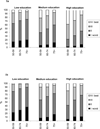Cognitive function, numeracy and retirement saving trajectories
- PMID: 22228911
- PMCID: PMC3249594
- DOI: 10.1111/j.1468-0297.2010.02395.x
Cognitive function, numeracy and retirement saving trajectories
Abstract
This paper examines the extent to which cognitive abilities relate to differences in trajectories for key economic outcomes as individuals move towards and through their retirement. We look at whether differences in baseline numeracy (measured in the English Longitudinal Study of Ageing in 2002) and broader cognitive ability predict the subsequent trajectories of outcomes such as wealth, retirement income and key dimensions of retirement expectations. Those with lower numeracy are shown to have different wealth trajectories both pre- and post-retirement than their more numerate counterparts, but the distributions of retirement expectations and net replacement rates are similar across numeracy groups.
Figures




References
-
- Aguiar M, Hurst E. Life-cycle prices and production. American Economic Review. 2007;vol. 97:1533–1559.
-
- Ainslie G. The Breakdown of Will. Cambridge: Cambridge University Press; 2001.
-
- Ameriks J, Andrew C, Leahy J. Wealth accumulation and the propensity to plan. Quarterly Journal of Economics. 2003;vol. 118:1007–1048.
-
- Banks J, Blundell R, Tanner S. Is there a retirement-savings puzzle? American Economic Review. 1998;vol. 88:769–788.
-
- Banks J, Emmerson C. Public and private pensions: principles, practice and the need for reform. Fiscal Studies. 2000;vol. 21:1–63.
Grants and funding
LinkOut - more resources
Full Text Sources
